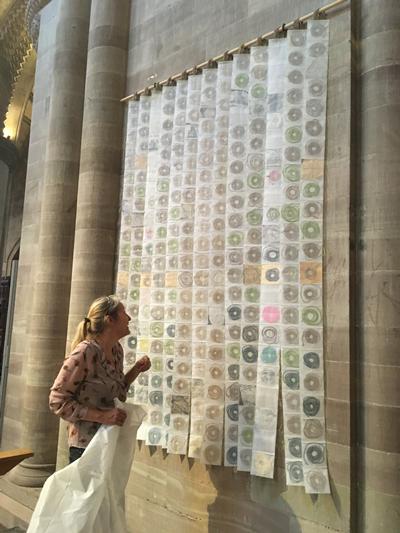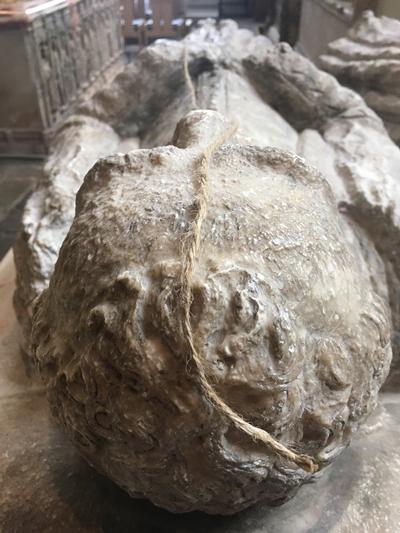
A collaborative engagement partnership exploring research into ‘place’, ‘journeying’ and the relationship between the medieval and modern, combining a touring art exhibition and public workshops.
Project Lead
Chloe McKenzie - doctoral researcher in English, Faculty of Art & Humanities (now Research Fellow at Centre for Medieval & Renaissance Culture, University of Southampton)
Purpose
To offer visitors and participants the opportunity to engage creatively with notions of mapping, place, and journeying, and to consider how our modern lives intersect with and relate to the medieval world.
The touring exhibition sought to acknowledge the significance of the selected venues as heritage sites, promoting the role of the church as custodians of medieval artefacts, and encouraging visits from a wide cross-section of society, regardless of faith; and in the process, opening up elements of the locations that might otherwise be obscured to visitors.
Audience
Members of the public, in particular those with a connection to the St Thomas Way project and people attending the launch event from the local area; with targeted activities for adults and family groups.
Background and motivation for the project
The project built on engaged, practice-based and collaborative research opportunities emerging from the AHRC-funded St Thomas Way Project.
Partnerships
Collaborative partner: artist Michelle Rumney
Approach Taken
Preparatory visits to heritage sites along the ancient St Thomas Way pilgrim route in Wales and Herefordshire identified three host venues along the route – significant medieval pilgrimage sites resonating with the project: Hereford Cathedral, St Mary’s Priory Abergavenny and St Mary’s Civic Church Swansea; contacts were established and the touring exhibition was scheduled for July 2018.
Rumney’s project work was inspired by the border-region landscape, the Hereford Mappa Mundi, medieval line maps and the practice of ‘Measuring to the Saint’ (a length of thread measured along the sick or needy person’s body was curled up and sent to the nearest cathedral or priory to be made into a votive candle). The idea that a humble piece of string might connect this world and the next, the modern to the medieval, inspired Rumney to use this practice to create her main exhibition piece. Engaging with and measuring over 250 people - plus one Great Dane and a teddy bear - she formed 13 strips, one for each waypoint on St Thomas Way, comprising 286 squares. These interactions explored a sense of space and time through physical contact, making personal connections, and discussing the project. Like the lengths of string made into candles in the Middle Ages, each piece of string represented a person, who would make a metaphorical journey to the sacred spaces that hosted the artwork.
The temporary art displays were hung among the permanent fixtures and ancient artefacts on site, starting at Hereford Cathedral to coincide with the launch of the St Thomas Way project on 7 July 2018, and progressing to subsequent venues during the summer and early autumn. Several weeks were spent at each location, coinciding with other cultural events which boosted exposure.
The exhibition was shared via digital media. As an entirely unforeseen extension to the project, Rumney partnered with Google to borrow a StreetView Camera to put internal images of the venues on Google Maps, including some virtual tours.

The project team hosted two public workshops (one ‘family’, one ‘adult’) at the Hereford launch day. Using the Mappa Mundi as a starting point for discussing medieval maps/mapping, and the shrine of St Thomas as a base for experiential ‘measuring to the saint’, participants were encouraged to lay thread trails to explore less promoted/obvious parts and features of the Cathedral. The family workshop adapted the measuring process to create a labyrinth and ‘see how far they could go’ having tied all the threads together in a long length. This highlighted the intuitive use of measures of the body to navigate space and time, something that was common practice in the Middle Ages when units of measurement (inch, foot, yard, mile etc) corresponded to body parts or human strides.

Achievements/outcomes
The artwork was very well received at all venues, as expressed in visitors’ books and by venue custodians. It sparked conversations between staff, volunteers and visitors, helping to embed the locations within the St Thomas Way and promote them as sites of medieval interest. At Swansea St Mary’s (heavily bombed in WW2 so nothing of the medieval building remains) the exhibition and the story behind it enabled the church to contemplate and discuss its history and heritage. The exhibition drew visitors into the Trinity Chapel, a place towards the rear of the church rarely visited by tourists.
As at 28 Sept 2018, over 33K people had viewed StreetView images world-wide.
The workshops brought together individuals from all over Wales and Hereford, along with people from as far afield as Dorset and Southampton. An additional family ‘creative mapping’ workshop was requested by St Mary’s Swansea.
Multiple other venues along the Way have subsequently hosted the exhibition (2018-2020).
Challenges and Lessons Learned
The project has allowed the researcher, Chloe, to challenge her notions of scholarship and its limitation, as well as offering new interpretations on our historical relationship with the past. The workshops offered her new perspectives on the use of sacred space, journeying and the potency of story-telling in enabling people to interact with the past.

Legacy
As a result of this project, McKenzie and Rumney have been successful in obtaining further funding from the University of Southampton and Arts Council England.
In January 2019, the Lighthouse Centre for Arts, Poole, hosted an exhibition – Map of Mundi – featuring artwork created for the Re-Making Maps project along with new pieces created by Rumney.
Arts Council England funded various workshops and, with their support, Rumney was able to create a ‘Dementia Friendly’ exhibition.
As a result of this work, Rumney was invited by Southwark Cathedral to create the Lent Art Installation from February – March 2020.
In November 2019, McKenzie, along with Rumney, led an interactive exhibit at the Hands on Humanities Open day (part of the University of Southampton’s Human Worlds Festival), which allowed visitors to learn more about Southampton’s medieval heritage through the historic practice of measuring to the Saint.
Links to external websites
The University cannot accept responsibility for external websites.